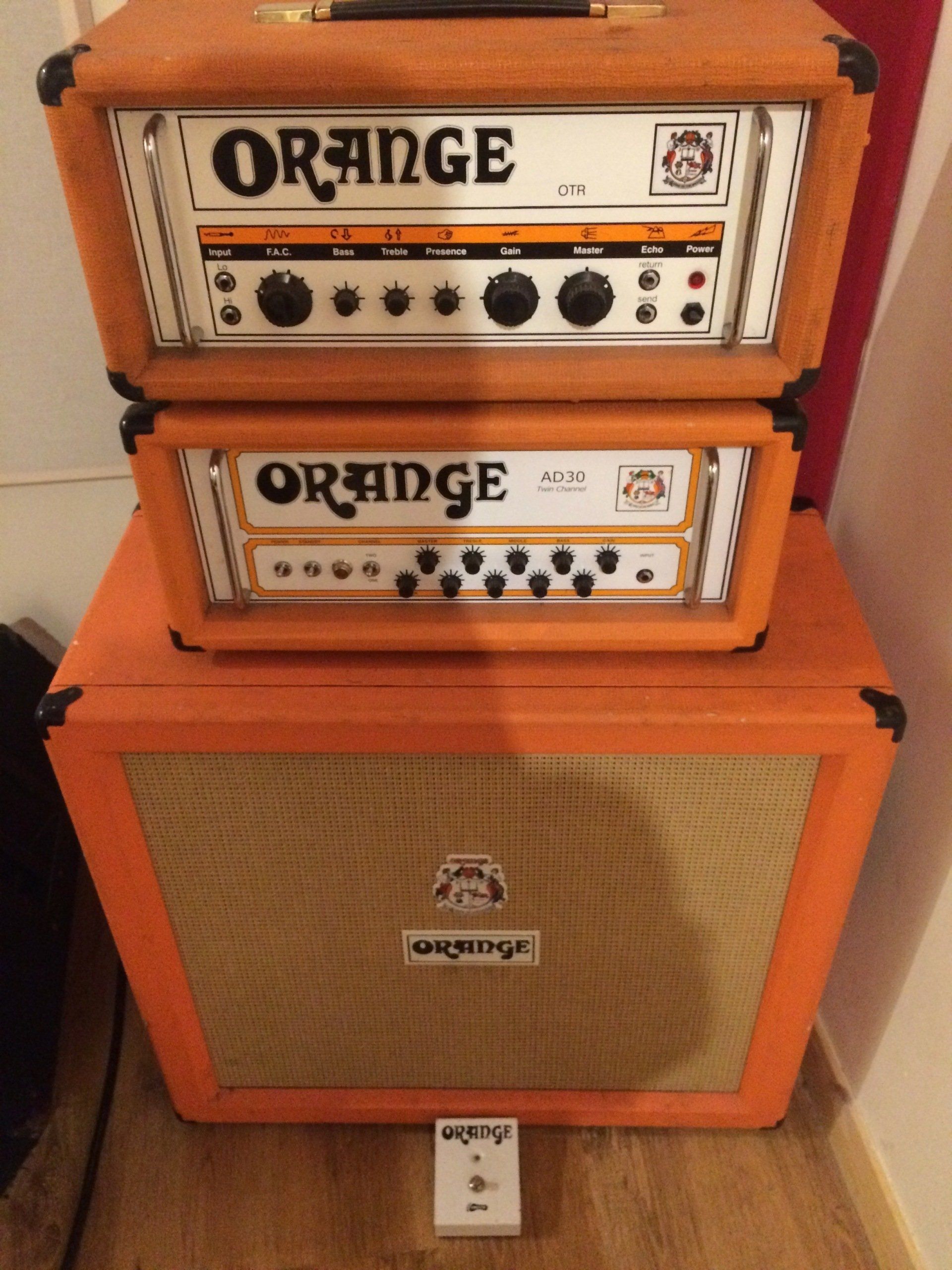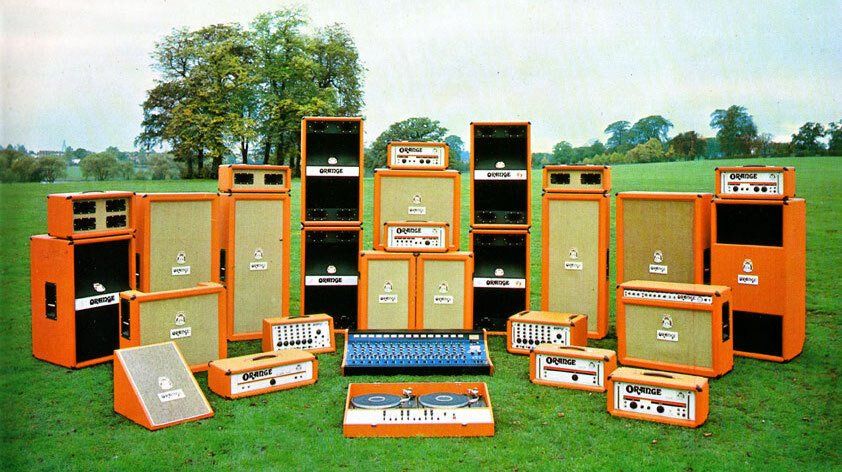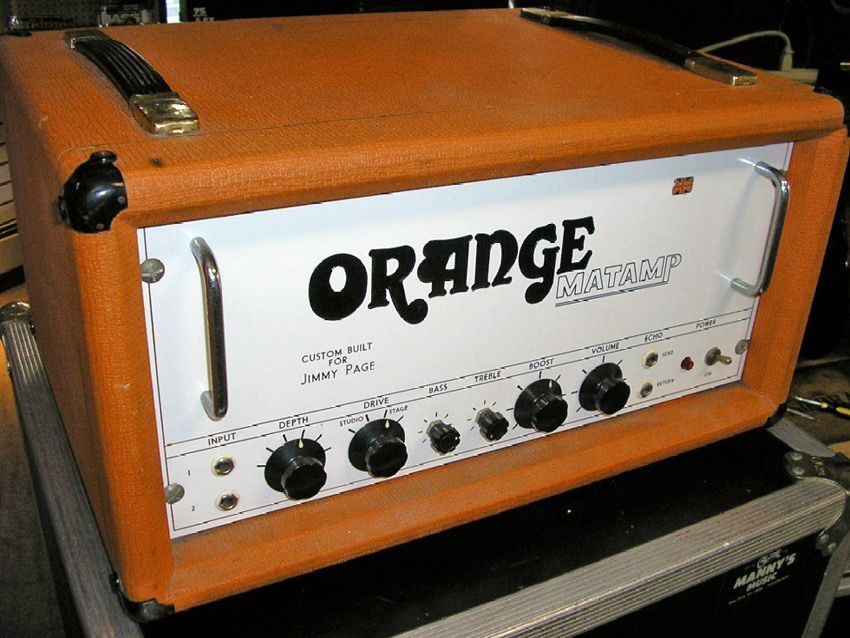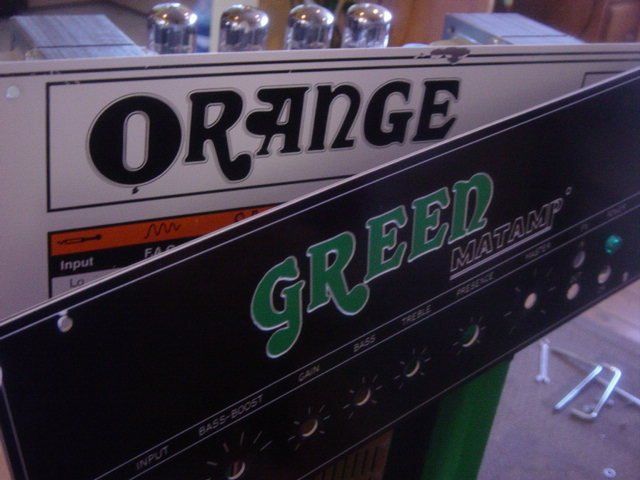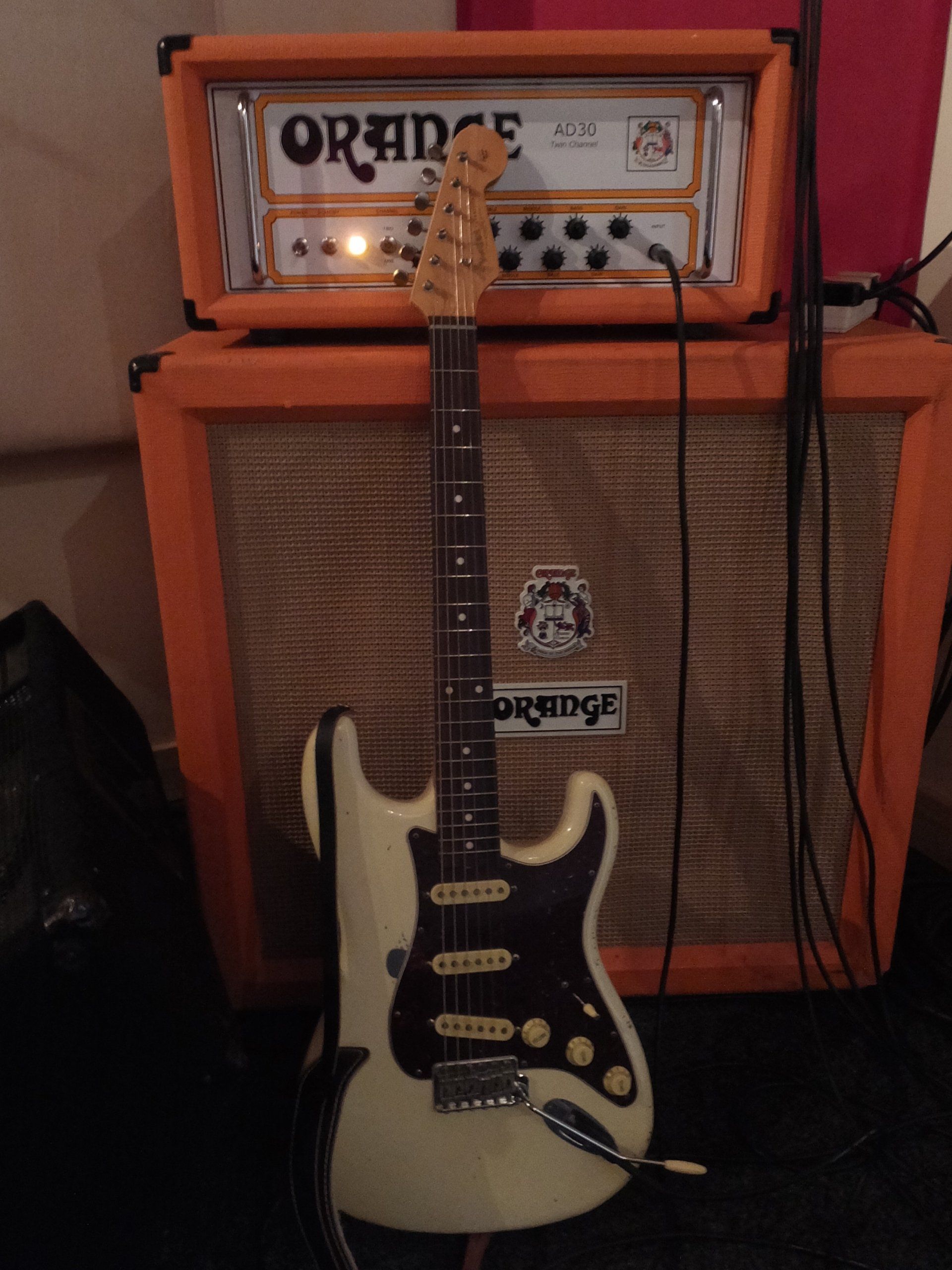English Seville War…
… getting the juice from Orange.
Soldier Of Orange
In the war for the hearts & minds (& wallets) of guitarists the battle has always been fought on two fronts, since both sound & vision need to be appealing for anyone with a creative bent. Few brands have done as much to stand out with their visual appeal as the Orange Music Electronic Co. Ltd. When Rhett Shull put out a video on the legendary British amplifier marque last September he concentrated on two Orange models: the OR120 and AD30 amp heads. The former representing those classic ‘hundred watters’ that appeared at the end of the ‘60s (which were soon re-rated at 120 watts in the early ‘70s), before being revived in the re-issue amps of the 1990s; and the latter being the Vox-with-grunt sound of their
fin de siecle AD30 design. The OTR120 and the Twin Channel variant of the AD30 just so happen to be the two models of Orange amp heads that we keep at New Cut Studios as well. I’ll include a link to Rhett’s excellent little film later, but for now here’s a run-down of these two great sounding amps and their place in Orange history.
Although Rhet goes into what defines the classic Orange sound later in the piece, he kicks things off with what is probably many people’s idea of the modern Orange Sound. The AD30H is a 30w amp head, GZ34 rectified, running 4 x EL84 power valves in a similar way to the original 1959 twin channel Vox AC30/4 circuit, but with no Vib-Trem option. Actually even more like an AC30 is the Orange AD30R combo, paired as it is with 2 x 12” Celestions. The AD30R however is only a single channel amp and, unlike the signature Vox circuit, it also has a reverb tank as indicated by the R suffix. The other version of this amp is the AD30TC Twin Channel combo. Where the two channel AD30 differs most from a three Vox AC30 is perhaps in having only one input (Hi & Lo jacks) but two complete sets of controls for each channel
— allowing both a clean and driven sound at the kick of the footswitch. Our AD30HTC here at New Cut is certainly a great sounding amp and I presume the suffix stands for ‘Head Twin Channel’. The single channel AD30 head and the reverb combo (as well as the AD15 1 x 10” combo) were all introduced in 1998, with the Twin Channel AD30 head & combo both coming along in 2001. Looking at the serial number of our AD30HTC, this particular Vox-in-a-Lox-coloured-box was put together in July 2006.
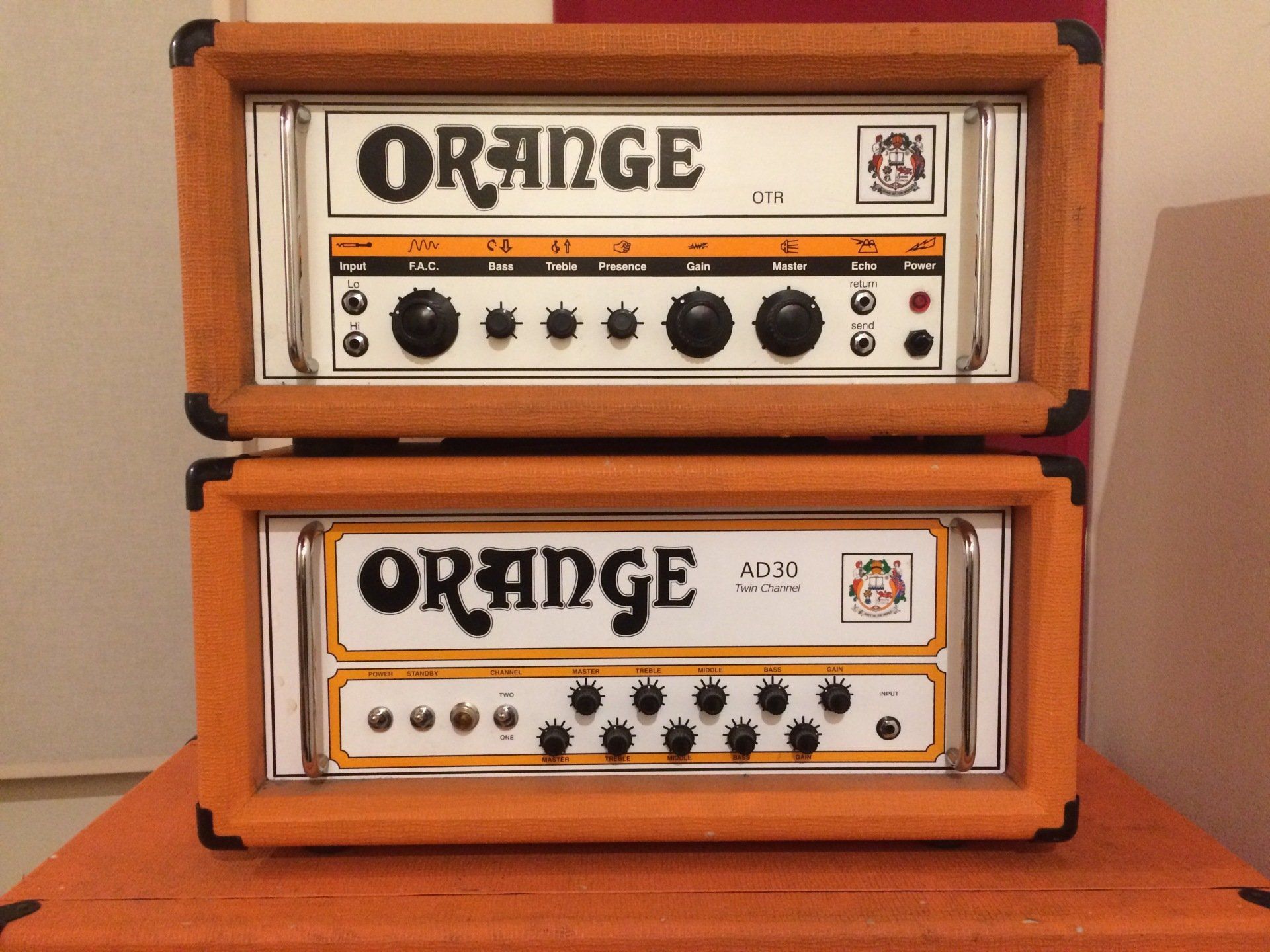
'Tangerine'
Jimmy Page played original Orange Matamps back in the day before getting his custom OR200s; but when he returned to the Orange fold at the end of the century he did so with the AD30 heads, initially the single channel and then the AD30 Twin Channel like the one at New Cut. When the long-dreamed-of Led Zeppelin reunion finally happened, an Orange spokesman remarked: “Jimmy Page essentially took care of our entire 2007 marketing campaign in a single night.” The accepted story of Orange amps on stage with Led Zep in the ‘70s, is that Page only ever used them for his theremin. But if that’s the case why were Orange his go-to guitar amps in the new Millennium? Of course Pagey is cagey about his amps and his tones
— and has always been. And he’s aways been a magician, with Mr Crowley’s help… all he had to say was Supro and the price of vintage 1690T Coronados went through the roof. It also turned into a tidy money spinner when handbuilt repro versions of his modified 1690 went on sale
— the 2x10"s were swapped for a single 12" and the 5V4G rectifier for a GZ34. However, there are tales of him using only a Tweed Champ with his dragon Telecaster to record most of the first two albums. Along with a persistent rumour that whatever the stack-line on back of the stage, back in the Led Zep day, it was only ever a Champ offstage with a couple of mics that actually got sent to the PA.
Comparisons between the Orange AD30 and Vox AC30 began as soon as the AD went on sale, and this was surely intentional. The similarity in name and circuit type had to be a marketing move right from the off. A little later I’ll include a link to a bit of footage of an AD30 and an AC30 used side by side on stage to great effect at the hands of PJ Harvey. The interest in Vox’s classic combo in the ‘90s was possibly higher that it had been in 30 years (partly due no doubt to the really solid, Marshall-built AC30TBX which came out in 1993
— now there’s a blog in waiting), but also because of all the other Vox-A-Likes being used by a variety of ‘cool’ new artists back then. Amps like the acclaimed Matchless C30 got a lot of attention, Laney jumped on the bandwagon with their very Voxy VC30 and even the Crate Club 30 got close to the sound. This has led to the AD30 mistakenly being called a Class A amp (even on dedicated Orange websites) just as the AC30 is often wrongly described. Class A circuits are always low wattage amps by virtue of their simplicity: by definition they are single ended designs, i.e. they have only one output valve or “power tube”. You’re not going to get much more than ten watts out of an EL84 in any single-ended configuration. But a pair of 84s in a Class A/B circuit can yield about 50% more wattage (yeah, that’s right, an AC15 is not true Class A either). So a quartet of 84s can get you around 30 watts of push-pull output. The Vox AC30 is a Class A/B design, biased hotter than than most other fixed bias Class A/B amps, close to the voltages of a Class A circuit*. It doesn’t help that even the Orange website claims that “Every retro, Class A tone you need is right here, thanks to four EL84s, a GZ34 (5AR4) valve rectifier and a pair of 2-stage channels, each providing a different flavour of no-nonsense Orange tone.” It is another triumph of marketing spin, the AD30 is not Class A, it is a Class A/B circuit similar to the AC30 that inspired it**.
"…Got my spine, I’ve got my Orange Crush."
The Orange OTR meanwhile, introduced in 1997, was an update of the ‘90s reissue OR120 Overdrive model, and was developed by Orange’s then new design chief Adrian Emsley in consultation with Noel Gallagher. It was another re-launch for the Orange marque as ’97 was the year in which the brand was put back in the hands of it’s founder Cliff Cooper. The OTR that we have at New Cut is on long term loan from top roadie & chef Jef Streatfield. The OTR is a very different beast from the various AD30 models. You don’t get any of the Voxy squishyness of a tube rectifier with the OTR: the schematic for this amp clearly shows four diodes in the classic diamond configuration of the full-wave bridge rectifier instead of a GZ34. The OTR was the last of the old style amp heads (it also came out as a 2 x 12” combo) before Orange started making the “Classic Brit” AD30 range of amps at the turn of the Millennium. A set of four EL34s produce a much bigger output wattage than the 4 x 84s in the AD30: it is nominally rated at 120w RMS, though I don’t know what kind of THD they allow. But the Orange tradition of putting 120 in the model numbers of their EL34 quad amps can’t be ignored I guess.
The development of the Orange sound from the huge, clean output of the first Matamps, to the Overdrive model in the early ‘70s began with an investigation into why other brands of British amp appeared to be louder than Orange. Orange originator Cliff Cooper, amp designer Mat Mathias and a team of famous consultants were most put out to discover that whilst a prominent market-leading British amp was only putting out 96 watts RMS by their measurements, it sounded far louder than their OR amps that were clearly measuring 120 watts RMS output. Orange were already naming their 4 x EL34 amps the OR120 model by this time, with variations on that designation appearing over the years. After consulting a Harley Street ear doctor to resolve the discrepancy in auditory volume, Orange started to introduce more distortion to their circuit for more “perceived loudness”
— with the tone stack and phase inverter receiving the most modifications. This new circuit developed into the first “Pics-Only” heads which had richer harmonic distortion and more sustain. They had a characteristic mid-frequency saturation and were fatter, warmer sounding amps. The text-free faceplate on these models with idiosyncratic pictograms labelling the controls also added to Orange’s very individual brand identity.
Shapes Of Things
Officially named the ”Graphic Valve Amplifier" this amp was designed by John James in 1971, and nicknamed the "Pics-Only" simply because there was no text on the face plate but only stylised symbols to identify the control knobs. The Cooper-Mathias partnership had dissolved due to the small Huddersfield operation failing to meet demand. The name Matamp was dropped and the simple white faceplate with clear wording became both more ornate and colourful, and the “Voice Of The World” crest appeared as well. It made the amps less industrial looking and added a little zest to their styling. The old Orange Matamps had their tone stack post preamp, but James’ Graphic amp introduced a Baxandale EQ at the front before the first gain stage and the phase inverter. Peter Baxandale who worked for the Telecommunications Research Establishment was another of those WWII boffins who advanced audio technology enormously. The phase inverter itself was changed from the Matamp implemented ‘concertina’ PI which was DC coupled, to a capacitor coupled design that would drive the output valves harder for more crunch. The first Pics-Only Graphics went into production in 1972. Early Pics-Onlys are known as Plexis for their reverse printed perspex backplate, which in later iterations was metal. Pics-Only amps are often found with the model number GRO120. The Graphic 120 added text to it’s iconic heiroglyphs in 1973 for easier interpretation, and these are often called the “Pics&Text” amps. Twenty years later when Gibson bought the rights to the Orange name, they went back to Matamp in Huddersfield to build their amps. Mat Mathias was sadly unable to help, having passed away in 1989, but Matamp would build modern versions of the Overdrive and Graphics models, both in 80w and 120w heads (there was also a Super Bass 120 head, but I don’t know how much the circuit differed from the “guitar” models). The Pics-Only cosmetics were later revived with the OR50H in 2008 which itself was then reissued in 2012.
Matamp of course made the original amps for the Orange shop in 1968, but after Mat Mathias died the Matamp brand was then taken over by Jeff Lewis in 1992. So, that mid ‘90s OR120 model had actually been built by Matamp in the UK under the direction of Gibson from 1993-97***. Noel Gallagher started playing one of the Gibson era Overdrive ORs, through a PPC412 box, around 1995 when Oasis were making their second album. When Cliff Cooper got control of the brand back from Gibson, Gallagher was by far the most prominent Orange user, and so they asked him what kind of amp he would commission. And the OTR, an update on the ’70s Overdrive head, was the result. In the late ’70s, market demands had led Orange to add a master volume circuit to the OR120 and label these models with the Overdrive name on the front panel. You can get an early OR120 to produce marvellous overdriven tone at high volume, but the Overdrive model’s MV control allowed this tone to be reproduced at lower levels of course. But there’s slightly more to the ‘90s OTR than that. To counter the consequent compromise in tone that many players lament in the master volume equipped amplifiers, this new Orange Overdrive circuit introduced a lot more overdrive and snarly, midrange push to the OTR tone and added a little more high end clarity.
This was how Orange described it: "This amplifier is the Overdrive 120 4 x EL34 enhanced by eighteen modifications. Introduced in 1997, OTR stands for Oscillatory Transition Return. The OTR 80 is the 2 x EL34 version. The very early models featured the letters OTR on the front panel in a much larger font. Sound modifications suggested by Noel Gallagher gave the Overdrive more sparkle, and they formed the basis of the new OTR.” Emsley remembered Galagher’s contribution to the design thus: “We talked through what he would like in order to improve his sound. Oasis were on tour with U2 at the time and using Orange combos, and I remember Noel just said ‘I want more crunch out of them’. As a result we made some changes to the Overdrive circuit which included modifications to the phase inverter and preamp. We also added a stand-by switch which replaced the output socket on the back. Sound modifications suggested by Noel Gallagher gave the Overdrive more sparkle, and they formed the basis of the new OTR amplifier (Oscillatory Transition Return).” ****
Ocelot Training Régime
Nobody seems to to have a good explanation for the name ‘Oscillatory Transition Return’, unless it’s meant to be a reference to ‘oscillatory transients’. Maybe the grid wires were too long in some designs of the OTR output circuits and the capacitance between screen & grid had to be tamed. Maybe the grid stopper resistors had to be upped in value. EL34 and 84 valves usually need bigger grid stoppers than 6L6 and 6V6 tubes because they are more susceptible to oscillation. Maybe Orange just felt the name reflected their return to older models and the transition of the brand back to the Cliff Cooper camp. The Orange name had certainly been ‘oscillating’ between several different owners for 30 years. Maybe it was just a random letter added to the classic OR designation. After pondering this for months I have decided it is a nonsense phrase that sounds like it means something but intimates more than it illustrates. I now think it stands for Over The Rainbow
— we’re not in Kansas anymore kids. Anyway, the slight revisions made to the classic Orange Overdrive circuit to give Oasis’ a more pithy Orange tone, clearly make the OTR a direct scion of the lineage. It’s not so very different from a Pics Only amp with a few resistor values changed in the phase inverter and for the output grid stoppers. The back panel of the OTR at New Cut Studios has the original “MODEL OR” print above “SERIAL No.” on the back as part of it’s silk screen, and then in black felt marker, “120” for the model and below it the serial number. But then almost every Orange amp head since 1971 would seem to share the “model number” OR120. I have also seen pictures of ’77-’79 Overdrive heads that have the model number OR120M on the back plate and in 1979 they introduced a version called the Overdrive Series Two with OR112M printed on the back.
So the look of the New Cut OTR120 harks back to the 1973 OR120 — having as it does both glyphs and words above the controls. And most of these labels are familiar enough descriptions of the amplifier’s knobs. Except for F.A.C. anyway. If OTR is esoteric then FAC proves to be even more arcane and I don’t know if Orange ever defined it. Later descriptions of the FAC knob (attached to a rotary switch of course rather than a potentiometer) range from Frequency Attenuation Circuit to Frequency Analysis Control, to Freakin' Awesome Control and most people have Fuck All Clue as to it’s action. Musicians, I say this to you now: if ever the controls on a bit of kit baffle or confound you, just mess around with them and use your ears. Whatever it’s abbreviation the FAC is simply a varitone switch, like you might find on an old Gibson guitar. It is basically a high pass R/C filter where the signal goes through one capacitor before being sent through a series of up to five more caps via the rotary switch. So in the counter clockwise position the signal only passes through the initial capacitor before hitting a resistor to ground. This position allows the most bass through the circuit. All the way clockwise and it passes through all six caps getting increasingly toppy with each click to the right. But also the signal’s gain is reduced for some frequencies: because the FAC is a high pass filter, varying capacitance through a 100K resistor but also through the 220K grid resistor of the next gain stage, the signal is amplified differently depending on it’s harmonic content*****. The FAC is a versatile tone control and gets some varied characteristics that with a bit of fiddling with the rest of the knobs can emulate other classic British amp inflections. Try playing with how much bass is determined by the FAC and how much with the Bass pot, you’ll be surprised at how differently the frequencies are cut or boosted by the different controls. Introducing more bass with the pot will also dial in more mids, for example.
Orange messed around with their front panel labelling quite a lot, for instance mid Seventies Overdrives often had the Presence control labelled H.F. Drive (high frequency). On a lot of Graphic amps the Bass and Treble pots were sometimes identified with bass & treble clefs, with the knobs further marked with Hz & kHz respectively. On some models, including our OTR, the bass clef was printed partially back to front. Although many guitarists have said they don’t have quite the same “feel”, most agree the sound of our OTR is pretty close to a ’70s Overdrive. Looking inside it is very much like a ’70s Overdrive
— but the phase inverter is more like a later Pics-Only amp, and the presence circuit is missing an inductor. As you can see in the pictures on this page we also have an Orange PPC 412-C, 240w 16Ω 4x12" cab
— and it works great for the AD30 HTC it came with, but it’s quartet of modern Celestion Vintage 30s don’t really suit the OTR. The ’70s cabs had Celestion’s original G12H Green- and Cream-backs. It would be interesting to reload the cab with modern G12H speakers or even try out something like 75w Eminence Wizards.
"Tangerine trees and marmalade skies."
So how did the story of Orange blossom in the first place? In 1968 Clifford Cooper opened his psychedelic studio and music shop at number 3 New Compton Road, between Carnaby Street and Tin Pan Alley. The recording studio was in the basement, so he decided to use the existing shop-front for retail. It was London’s first ever shop dedicated to used musical equipment, which came about basically because Cooper had trouble establishing supply links from manufacturers. He ended up selling his own band’s equipment just to keep the shop and studio open. On the first day he sold his own Vox amps and cabs. Because none of the suppliers or amplifier makers would grant Cooper a dealership to begin with, the Orange shop decided to commission their own range of amps. In those days manufacturers like Selmer and Vox had their own retail outlets nearby on Denmark Street & Charring Cross Road, so Cliff Cooper’s approach was pretty much the reverse business model. He did manage to establish the shop as a retail dealership for some brands and was soon importing guitars from the likes of Gibson and Fender ******.
There are plenty of versions of the Orange origin online if you want to do your own research, but basically Cliff Cooper understood enough about electronics to get a guy called Mat Mathias to develop his existing smaller guitar amps into a 100 watt guitar head with variations for bass and PA. And thus the first white-face Orange Matamp head was born, apparently using a pair of KT88s to put out 100 watts. By 1970 several Orange Matamp models were developed by the official partnership of Cooper Mathias Ltd.: there was a 200w bass tailored head with twice the number of KT88s, the OR100 guitar head became the now standard EL34 quartet, with an EL34 pair driving the ORST50 “student model”. Although the white face Orange Matamp OR200 (powered by a quartet of KT88s again) was used to great effect by Jimmy Page and Peter Green, supposedly only 200 of them were made, beginning in 1969. It was an interesting modular design with separate preamp and power amp chassis. Different preamps tailored to bass or organ for example could then be put into a cabinet with a standard “flat response” power amp
— this output stage “flat amp” was based on a circuit from the GEC handbook. The massive Partridge transformers in these 200w behemoths were too heavy for Mathias’ aluminium chassis, buckling the frames of the amps that went out on that 1969 Fleetwood Mac US Tour, so new pressed steel boxes had to be made.
Mat Mathias had founded a company called RadioCraft after the end of WWII initially as a radio repair shop in Huddersfield. In the early Sixties the electric guitar boom created a huge demand for gear, so Mathias was experimenting with amplifier circuits in collaboration with his friend Tony Emerson. Emerson had a valve HiFi design which they modified for instrument use, developing 20w and 30w guitar amps, and coining the name Matamp in 1962 from
Mat
And
Tony
AMPlifiers. “Mathias
— the amps designer
— had a large bump on his forehead which we all reckoned was the extra bit of brain that God had given him in order to design the Matamp. He worked for the British army in WW2 way back in the 40s and had designed his stuff then for Army use and had kept the blue-prints till the 60s when the demand for guitar amps blossomed. Strange to think that Mr Hitler and his antics influenced rock technology!” (Martin Turner, Wishbone Ash, 25 Dec 2005). Yeah, the Second World War moved technology on apace, and popular music benefitted a whole lot more than people realise. One story has it that Mathias was himself born in Germany and left for England in 1939.
The Orange marque will always be associated with Peter Green, and not only for the truly golden tones he drew out of them. I have read a quote that Green’s response to queries from Cooper and Mathias as to the kind of tone he was after elicited the following response: "I want it to sound sweet, but not like treacle. Like honey." It was an opportunity Cooper seized to supply all the amplification requirements for an upcoming Fleetwood Mac US tour that really kicked off the Orange amp story. The earliest designs were great for bass but were too clean and flat for guitar and didn’t give anywhere near enough of the sustain their customers were looking for at the end of the ‘60s. Throughout 1969 the impromptu think tank of Peter Green, Paul Kossoff and Marc Bolan, who all hung out at the Orange store, consulted on characteristics they wanted in the tone for Mathias to implement. Wishbone Ash, Free, and Led Zeppelin would become the first bands to follow Fleetwood Mac’s lead. Stevie Wonder, a man with an ear for good sounds, you could say, was another collaborator in the original Orange era and either contributed to the shaping of the Orange sound or simply endorsed it depending on whose accounts you read. Even Black Sabbath went Orange with a full backline of amps for an early filmed performance.
Back In Black.
When the early Orange branded Matamps were first built, late in 1968, Orange really was the new black. After all, every other British amp at the time was wrapped in black vinyl. There were no other gaudy, new model amps around at the time, certainly in the UK. Even Selmer, a brand with a colourful tradition, had gone black by this point, having hunted imitation silver crocodiles to extinction in the Essex Marshes south of their factory in Braintree. The last Selmer Silver Croc-skin vinyl amps came out in 1965. Fender had gone black in ’65 as well
— and would not reissue their 'Tweed' linen, or Brown & Blonde Tolex coverings for many years to come. Most new American amps were black by the late ’60s, apart from the funky padded pleats of shiny metallic vinyl that the Ross company clad their excellent solid-state Kustom amps in.
Of course in the modern era of Orange amps, they can be all kinds of colours, Green for Peter, Black for Polly
— some of the early 70’s Tour Range Matamps were black but had a huge badge saying “White” on the front. These were made for the White Sound music shop in Sunderland, owned by one Bill White who also owned the Rock City store in Newcastle. Orange style amps in a rainbow of colours from the US Electric Amp brand confuse the history of Orange and Matamp even further. When I worked for PJ Harvey and we were looking at amplifier options for touring an album campaign around the world for the next 17 months, me and Buddy her long time roadie & fixer, went through equipment that Polly had in a lock-up down in Dorset. Polly’s Orange gear in the lock-up was one of the early black Orange rigs. During the early 2000s she used an orange-Orange head & 2x12 cab in parallel with her mid ‘60s Grey-panel Vox AC30. However she wasn’t enamoured of the lurid look on stage, and I was told that she was the first client for whom Orange had agreed to cover their amps in black. For the Hope Six Demolition tour we ended up using four Vox AC30s on stage including Pol’s Grey-panel. We actually carried six AC30s, as well as a Fender LTD ’59 Bassman, an original Ampeg V4B half stack, a first issue Fender Blues~DeVille, and a Music Man 210
Sixty-five. It was my 1977 Music Man 210
Sixty-five that was rented from New Cut for the tour; and I bought the two Fenders and a Marshall AC30/6 TBX off the tour production for New Cut Studios in 2018. Here’s a pretty damn groovy example of what Pol can do with an Orange and a Vox in
sweet conjunction, when the Wessex Girl Played Essex V Festival -- of course the Firebird VII helps.
Mind the Oranges Marlon.
Can you believe that was her first single release, 12 years before that V Festival appearance? Some online equipment lists have Pol using a Retro 50 but I’m pretty sure it was always an AD30. I can’t remember what model the black one was because we left it in the lock-up and didn’t use it at all when I worked with her. I don’t know how many times the band played
The Orange Monkey during that year & a half run, almost every show I imagine; it seems a shame that we didn’t use an Orange amp for any of them. Certainly the head in the 2003 V Festival footage is an AD30H and there are photos of her with AD30s from other festivals around the globe that year. The Retro 50 Head introduced in 2002 was a master volume version of the Pics Only circuit, additionally it was the first of Orange’s "Custom Shop" labelled amps, which I believe were also hand wired. Early in 2014 Orange did a run of Rockerverbs and Thunderverbs in White Levant vinyl covering with gold piping and some matching white PPC212 & PPC412 cabs. There was also a ltd. edish in “blood orange” vinyl. Blood oranges, or
sanguinella, were first cultivated in Sicily in the 15th century, perhaps that’s why Coppola used the spilling of oranges to symbolise the spilling of blood in the
Godfather movies. (My eldest daughter is in her first year of film school at the University of Westminster, so we watched the first film of the trilogy a few weeks ago, which reminded me of that.)
I started this blog inspired by a great look at Orange tones in a video by Rhett Shull. Shull is an interesting vlogger who’s done some great articles, but he’s also a fine musician with a good ear and in this piece he pulls some Peter Green phrasing out of the bag when playing through some OR heads, and makes a pretty good fist of it. I don’t mean to damn him with slight praise; to my taste there have been very few guitarists with the touch and the sweetness that Peter Green had in his youth. “But not treacle. Like honey”. Check out the superb Fleetwood Mac
Live At The BBC album for some of the best British blues ever recorded. I have to mention Danny Kirwan here as well, Fleetwood Mac cohort from about ’68 to ’72, and a remarkable player for one so young. So here’s that
Rhet Shull video in which he talks about the AD30 & OR120 heads (even though he gets a bit mixed up about AD30s coming out of Gibson's stewardship of the brand); and where he also get’s to try out three awesome Orange heads owned by another interesting YouTuber, Rick Beato.
The ’90s revival of Orange produced a line of great sounding, reliable amps, with better wire dressing, voltage regulation and consistency of tone. The PCBs weren’t as heavy duty as the ’70s amps, and neither were the transformers, but the modern circuit boards are still pretty good quality and the irons are as good as those in most modern amps. Orange amps have a sound of their own, whether you want the big ’70s grunt of our OTR or the squishy ‘60s bloom of our AD30, New Cut Studios can offer you truly great guitar tones.
* Okay, lets get this straight right now, Class A amplification does not mean “top class, grade A, the absolute best”. When will copywriters, and musicians for that matter, get it through their skulls that saying Class A is like saying “most basic”? It is merely the first and simplest form in a classification of amplifiers that progresses through consecutive letter designations
— like when we talk about Class D high wattage bass amps. There are several classes of amplifier in this series, indeed the Class E model was first described in a doctoral thesis in 1964. On paper a Class D amp is pretty much 100% efficient: compare that to Class A designs which will never exceed 25% efficiency (unless it is inductor or transformer coupled at the output). In a Class A design the output valve is always lit, using more current but for less output. That’s what “single-ended” means, by the way, one output valve
— just like a Tweed Champ. The letter classification is there to distinguish between increasingly complex circuit architectures. A particular Class A amplifier is not superior to any individual class A/B amplifier
—
any superiority between models would depend on their relative design, components and manufacture. The Eurotubes website has this to say about the Orange/Vox comparison:
“The AD15 and AD30's are push-pull cathode biased amps which are biased up where a true class A amp would be, thus the claim in being class A. So now that we have gone past this, it does not detract from the sound quality. Orange amps have always had their own sound and the AD series is no exception. We are often asked to describe their tone by customers and while we hate getting the question ‘what amp should I buy?’, we do try to answer in generic terms and the AD15's and 30's do have a Brit thing going on but are not high centred like the VOX AC's are. The AD's are thicker with more mid range and low end girth. They do have a nice chime in the high end but not as pronounced as the VOX amps.”
** Class A/B designs are a way of using the better efficiency of Class B amps while minimising the unmusical crossover distortion that can occur between push and pull Class B output stages. The design of the tone stack and the type of output biasing will do more to colour the tone of a guitar amp than whether it is Class A or A/B. I don’t know that I’ve ever heard a Class B guitar amp, though I have read that Leo Fender designed the Music Man 112RP Sixty-five to run 4 x 6L6 tubes in pure Class B operation
—
but with little noticeable crossover distortion. Crossover distortion in Class B amps is usually due to increased odd harmonics, particularly 3rd order harmonics, and these odd harmonics are often buzzy and harsh next to the input signal (despite being valve generated). They are also increasingly audible against the pure tones as the signal decays
—
where we might usually expect a sound to get less abrasive as it fades away. These 112RP combos run 6L6s into ceramic speakers unlike the older MM designs pushing Alnico speakers with EL34s. The 122RP was also only single channel unlike most Music Man amps with their twin channel Fender heritage, but it had two effects loops
—
both high and low impedance. It also had a built in Phasor (sic) circuit.
*** At some point the building of Orange amps moved over to Trace Eliot, some PCBs in late ‘90s Orange amps are reportedly printed with the Trace Eliot brand and some AD30 amps have a Trace Eliot Q.C. sticker on the PCB. The manufacturing then moved away from the Trace Eliot factory sometime in 2002. Coincidentally Gibson bought Trace Eliot in 1998 after they dropped Orange, I guess the business connections were there between all three brands, and I believe there had been some transfer of employees between the companies. The Gibson “Goldtone” range of amps were restyled versions of Trace Elliot’s mid ‘90s valve amps. The Gibson “Goldtone” GA-15 was identical to the Trace Elliot Velocette, apart from cosmetics (the GA-30RVS was a Vellocette Twin). The best of these TE Gibsons was probably the Super “Goldtone” GA-30RV which paired a 12” Vintage 30 with a 10” Vintage 10 (60w G10 Celestion), driven by a very Voxy quartet of EL84s just like the AD30. We were given two Gibson Super “Goldtone” 60w 2 x 12” combos to tour with Archive when they came out. They looked pretty cool and really retro, black & gold styling with what looked like gold metal Victorian radiator grills over the speakers and the top vents. The GA-60s were twin channel A/B master volume amps with spring reverb tanks. They also weighed a ton, well maybe only 100 pounds or so, but they were really heavy amps, with a heavy look and a heavy tone. The pair or pentode sockets for the power amp were labelled for EL34/6CA7, 6L6/5881 and KT88/6550, and so very sensibly had the legend
Output valves !Please ensure these are biased correctly! printed above this. A task which was easily accomplished with three probe test points and a pair of trim pots on the back panel. The seven dual triode sockets were labelled for ECC83/12AX7/7025 for Preamp 1, Preamp 2, Preamp 2 again, Reverb Return and Phase Splitter; and marked ECC81/12AT7/6201 for Effects Loop and Reverb Drive. A recent visit (April '22) to Gibson Headquarters in Fitzrovia revealed that they have pretty much a full set of Goldtone amps set up on their showcase stage down in the basement.
**** When Paul Weller supported Noel Gallagher’s High Flying Birds at Bristol Downs Festival in August 2018, I noticed there weren’t any Orange amps on stage anymore. In fact when I first walked on stage I thought Noel had gone back to basics, in the nicest possible way, using a pair of LTD Tweed Bassman reissues, but it turned out they were for Jem Archer’s use. Noel had a pair of HiWatt 2 x 12” combos, presumably 21st century re-issues but I couldn’t get a really close look. The HiWatts were stacked on top of each other right next to a full stack draped in a Man City flag. I didn’t get a look behind the flag but it could have been a Vox AC50 tower. The HiWatts may have been the reissue of the SA 212 which was the combo variant of the DR 504 50w head. Sometime around 2007 I was chatting to my mate Jim Dare about what amps he would play with Brett Anderson as we rehearsed for a tour at the original Terminal Studios in Bermondsey. AC30? Bluesbreaker? Both were there in our armoury to wield courtesy of the the Suede storage cages (we went with the Marshall in the end). He mentioned he had a ’70s HiWatt at home that he was using as a coffee table
—
face down with a plywood board on top of it. I naturally WTFed at him and he shoulder-shrugged a musician’s response that it was broken. I told him he was using the Tonal Grail as a plant pot, so he brought it into Terminal Studios for appraisal. It was an SA 212 made in 1974 (if I remember right), with a pair of purple-back Fanes and when I opened it up, there was that glorious, neat wiring harness I always marvel at when I look inside a HyLight era amp. Partridge transformers, Mullard ECC83s & mustard caps, it was fantastic. Indeed Dave Reeves worked for Mullard for a while (and Marconi as well) and just like that other great amp builder Pete Traynor, he had a repair workshop at one time in the mid ’60s above a music retailers (Plato Music in Kingston-upon-Thames). The power switch was broken on Jim’s HiWatt, so a new toggle was installed, and a pair of new EL34s replaced the worn out power tubes. And that was it, all it needed, we fired her up and she was magnificent. Every now and then I’ve sounded Jim out about selling it to me but he wouldn’t let it go. I wish I’d been unscrupulous and told him I’d buy his coffee table. (I met up with Jim for the first time in ages today - 11/3/22 - at Factory Studios setting up rehearsals for The Editors. He couldn't sell me his HiWatt because an American collector gave him 5 grand for it during lock down.)
***** Grid stoppers also affect a valve’s input capacitance and this itself creates a low-pass (R/C) filter. Roll-off for this filter will be 6dB per octave as decreed by this formula: f=1/(2π x R x C)
— so more HF will be rolled off by increasing the value of the grid stopper resistor. If you increase the value of the grid stopper you also need to think about decreasing the value of the grid leak resistor which is effectively in series with the stopper resistor. But decreasing the grid leak resistor value will attenuate the signal more, because you’re changing the impedance bridging between the driver and the output valve.
****** Sometime in the early autumn of 1970, a certain Eric Clapton bought an Olympic White Stratocaster at the Orange shop. It was a somewhat uncommon left-hand model and he’d purchased it as a present for Jimi Hendrix. On the evening of the 17th of September he intended to hook up with Hendrix and give him the lefty Strat. They didn’t manage to get together however, and sometime early the following morning Jimi died. In Clapton’s own words it went like this: “The night that he died I was supposed to meet him at the Lyceum to see Sly Stone play, and I brought with me a left-handed Stratocaster. I just found it, I think I bought it at Orange Music. I’d never seen one before and I was gonna give it to him… He was in a box over there and I was in a box over here. I could see him but I couldn’t… we never got together. The next day, whack! He was gone. And I was left with that left-handed Stratocaster.” Just over a year later, Eric Clapton was supposedly one of the last people to see Duane Allman alive before he climbed on his motorbike, and again he was one of the last people to play on stage with Stevie Ray Vaughan before SRV stepped onto that fated helicopter, 20 years, almost to the month after Hendrix left the planet.
©️ Mark Vickers 18th April 2021.

